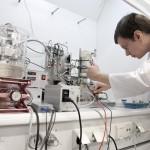 Fuel cells can create electricity that produces very little or even no pollution. In the future, fuel cells are expected to power electric vehicles and replace batteries, among other things. However, fuel cells are expensive.
Fuel cells can create electricity that produces very little or even no pollution. In the future, fuel cells are expected to power electric vehicles and replace batteries, among other things. However, fuel cells are expensive.
Now researchers at Aalto University in Finland have developed a new and significantly cheaper method of manufacturing fuel cells. Using atomic layer deposition (ALD), the researchers are making cells that incorporate 60 percent less catalyst material than would normally be required. The study is published in the Journal of Physical Chemistry.
“This is a significant discovery, because researchers have not been able to achieve savings of this magnitude before with materials that are commercially available,” says Docent Tanja Kallio of Aalto University.
In a fuel cell, chemical processes must be sped up by using a catalyst. The high price of catalysts is one of the biggest hurdles to the wide adoption of fuel cells at the moment. 
The most commonly used fuel cells cover anode with expensive noble metal powder which reacts well with the fuel. By using the Aalto University researchers’ ALD method, this cover can be much thinner and more even than before which lowers costs and increases quality.
With this study, researchers are developing better alcohol fuel cells using methanol or ethanol as their fuel. It is easier to handle and store alcohols than commonly used hydrogen. In alcohol fuel cells, it is also possible to use palladium as a catalyst. The most common catalyst for hydrogen fuel cells is platinum, which is twice as expensive as palladium. This means that alcohol fuel cells and palladium will bring a more economical product to the market.
These results are based on preliminary testing with fuel cell anodes using a palladium catalyst. Commercial production could start in five to ten years.

